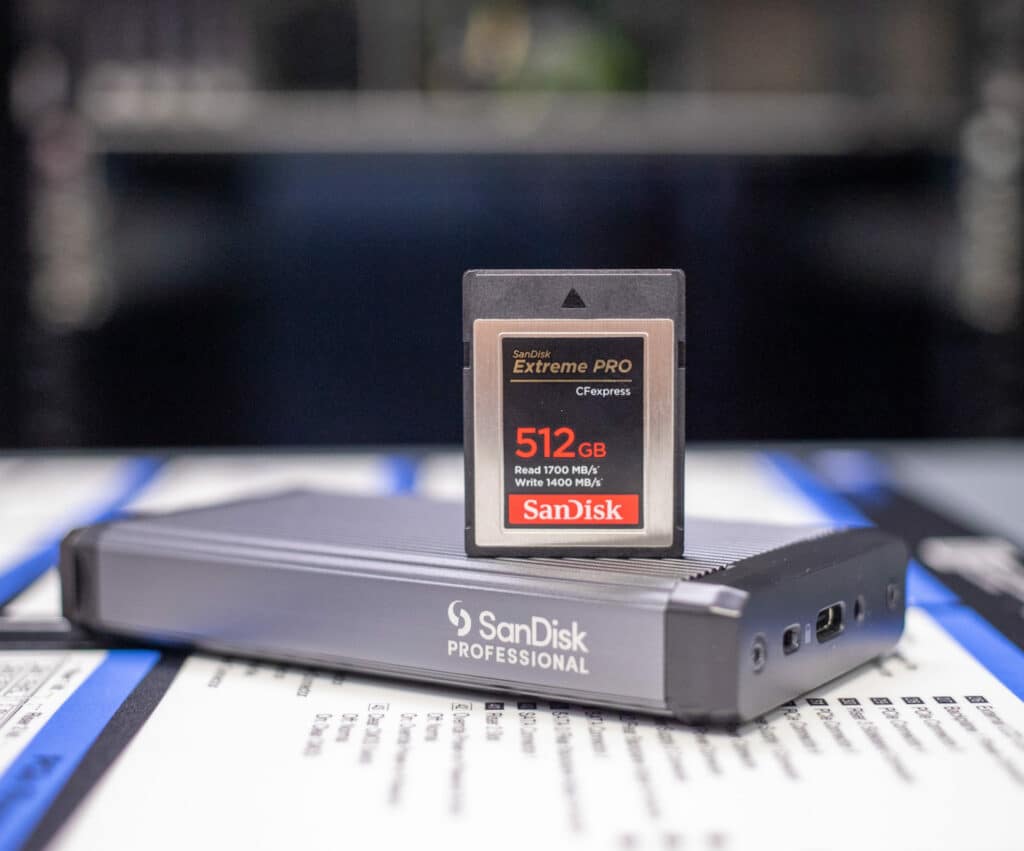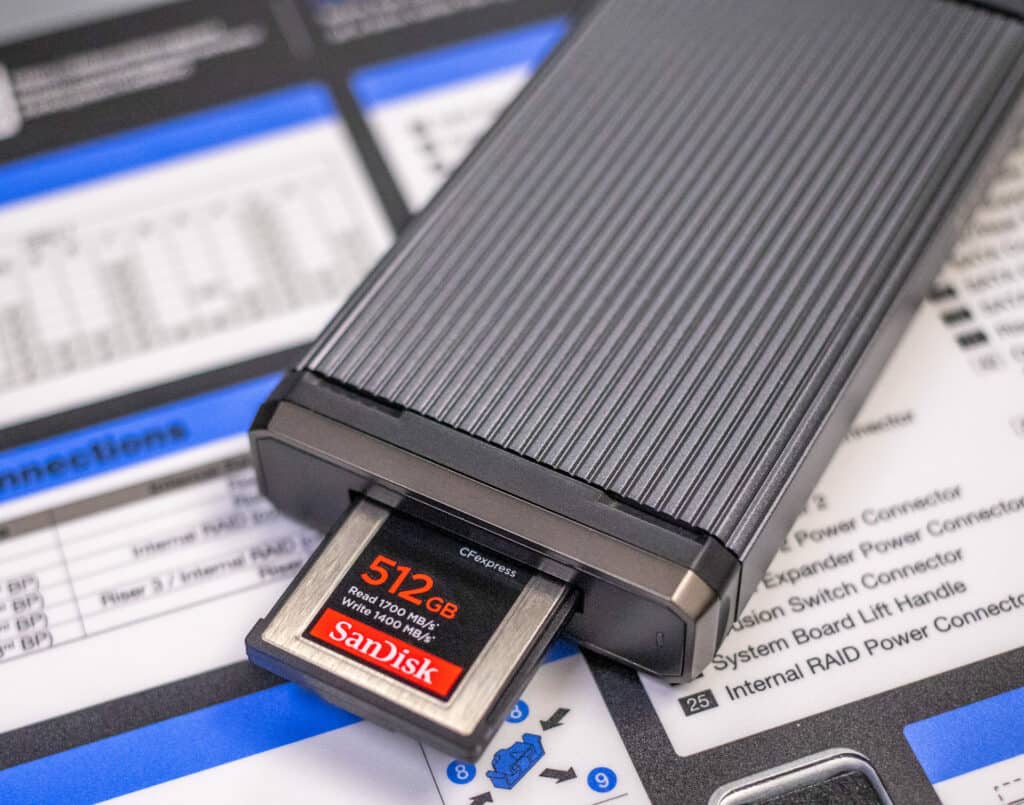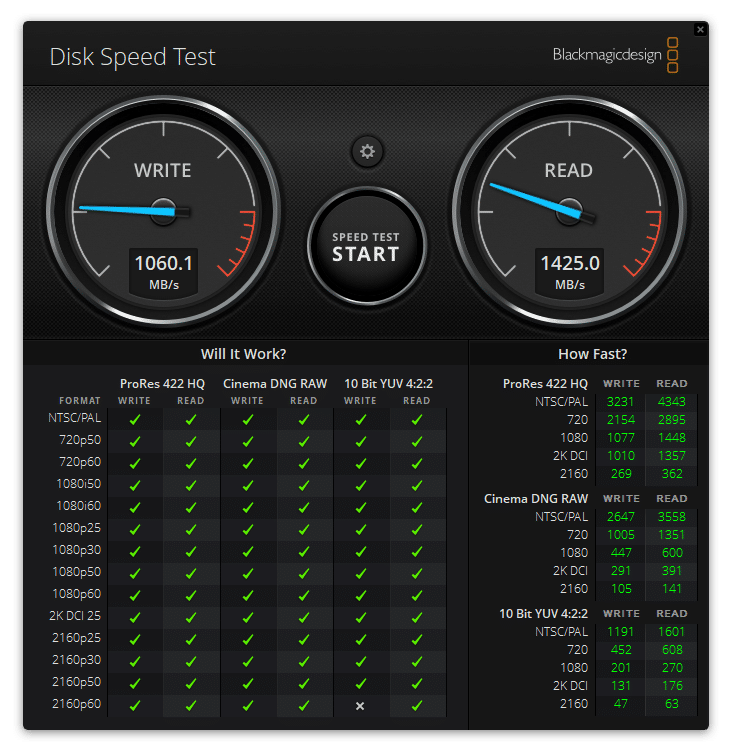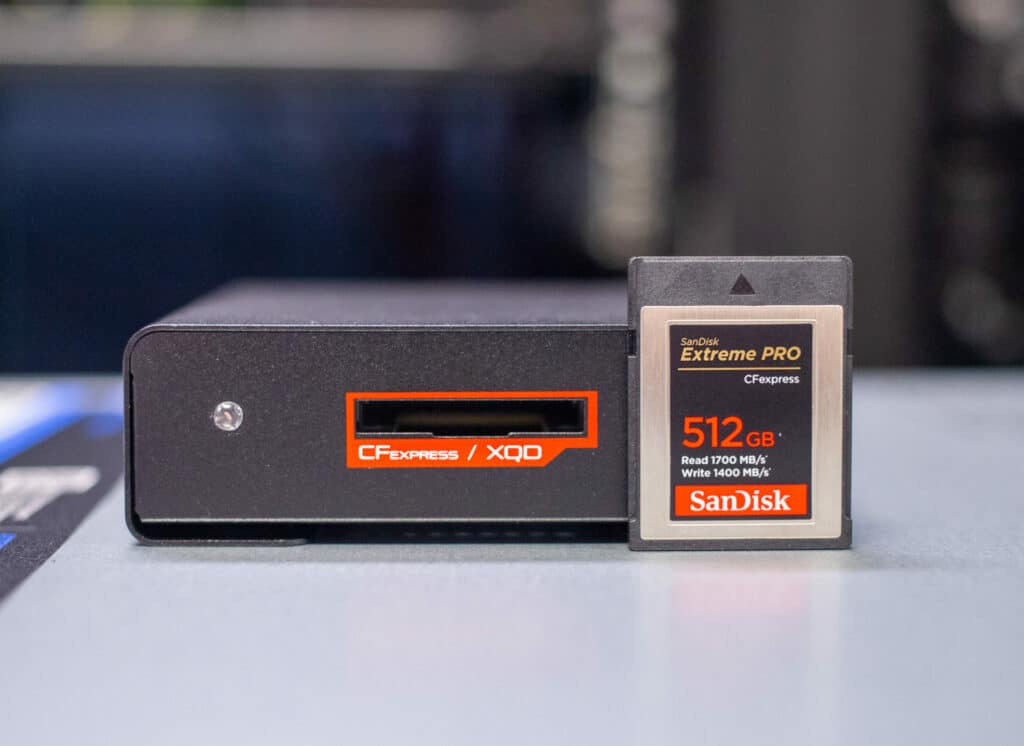The SanDisk Extreme Pro CFexpress is the company’s first memory card of this type to hit the market. Reaching the same speeds similar to NVMe SSDs, SanDisk’s Extreme Pro (which uses the Type-B form factor) allows content professionals in the film, photography and media industries to capture RAW 4K and 8K video with sustainable performance.
The SanDisk Extreme Pro CFexpress is the company’s first memory card of this type to hit the market. Reaching the same speeds similar to NVMe SSDs, SanDisk’s Extreme Pro (which uses the Type-B form factor) allows content professionals in the film, photography and media industries to capture RAW 4K and 8K video with sustainable performance.
The SanDisk Extreme Pro CFexpress is a step up from the CFast model of the Extreme Pro line, a solid release from the company that delivers performance more in line with SATA SSDs.
SanDisk Extreme Pro CFexpress

For performance, the SanDisk Extreme Pro CFexpress Type-B is expected to deliver sequential speeds up to 1,700MB/s read and 1,400MB/s write for the 512GB capacity, which is a bit better than the Acer CFE100 (1,600MB/s read and 1,200MB/s write). That said, the 256GB and 128GB models are quoted with slightly slower write speeds at 1,200/MB/s while the small capacity (64GB) is specced at 1,500MB/s read and 800MB/s write.
Nonetheless, this Extreme Pro line of CFexpress memory cards offers the fastest speeds available for cameras that support this interface, allowing professionals to have consistent quality and performance while recording in virtually any resolution. As a result, this will also significantly improve and speed up workflows–more than any other type of memory card available.
Those who purchase the Extreme Pro CFexpress card can also download the RescuePRO Deluxe data recovery software for free, a package that allows users to easily recover files that were accidentally deleted. This can certainly come in handy as it can potentially save professionals from re-shoots. SanDisk offers a generous, limited lifetime warranty (for those in the US), which means users can be assured that their cards will last as long as they need them. They are also backward-compatible with certain XQD cameras with firmware that enables CFexpress.
The SanDisk Extreme Pro CFexpress Type-B Memory Cards go for roughly $100 (64GB), $140 (128GB), $240 (256GB), and $450 (512GB) on Amazon. We will be looking at the 512GB for this review.
SanDisk Extreme Pro CFexpress Type-B Card Specifications
| Capacities | 64GB, 256GB, 128GB, 512GB |
| Speeds |
|
| Performance profile | Capture RAW 4K video with sustainable, low-latency performance |
| Compatibility | Backwards-compatible with select current XQD host devices |
| Support | RescuePRO Deluxe data recovery software downloadable offer |
| Warranty | Limited lifetime warranty |
SanDisk Extreme Pro CFexpress Card Design and Build
The Extreme Pro CFexpress card comes in at just over an inch in width and one and a half inches in height. Despite this compact design, this memory card is still able to output an enormous amount of performance for its size. CFexpress cards are able to achieve these speeds by leveraging the PCIe 3.0 interface and NVMe 1.3.
Featuring the usual black, red and white SanDisk design, the front of the card shows users just enough information. This includes the product name, form factor, capacity speed, and company branding. It’s important for professionals to have this type of information on the front of the card, as they most likely deal with a lot of different memory cards at the same time.
The back of the card reveals the usual supplemental information, such as product and serial numbers, certifications and other detailed information.
SanDisk Extreme Pro CFexpress Type B Memory Card Performance
To test the Extreme Pro CFexpress, we used the BlackJet TX-1CXQ Thunderbolt 3 CFexpress Type-B card reader. We also compared it to the Acer CFE100 and Lexar Professional CFexpress Type-B cards to show you how it stacks up against the competition so you can make an informed purchase decision.
First up is the Blackmagic test, where is posted a solid 1,425MB/s read and 1,060MB/s write. While these results didn’t quite reach SanDisk’s quoted numbers, they were better than the Lexar and Acer cards, which posted 825MB/s read and 487MB/s write and 1,276MB/s read and 1,004MB/s write, respectively (both of which used the same BlackJet CFexpress reader.
Moving onto the first IOMeter benchmark, we tested the SanDisk Extreme Pro, Acer CFE100 and Lexar Professional CFexpress cards in both a single-thread workload and 4-thread workload as usual. In the 2MB sequential workload, the SanDisk saw 1,086MB/s read and 965.7MB/s.
In the 2MB random loads, the SanDisk scored 1,036.7MB/s read and 397.4MB/s write while the 4K tests recorded 10,768 IOPS read and 3,145 IOPS write. Below is a table that compared all three cards and their performance.
| IOMeter (1-Thread) | |||
| Test | SanDisk Extreme Pro | Acer CFE100 | Lexar Professional |
| 2MB sequential write | 965.7MB/s | 280.05MB/s | 433.03MB/s |
| 2MB sequential read | 1,086MB/s | 1,165.88MB/s | 700.08MB/s |
| 2MB random write | 397.4MB/s | 145.87MB/s | 428.30MB/s |
| 2MB random read | 1,036.7MB/s | 754.88MB/s | 696.07MB/s |
| 4K random write | 3,145 IOPS | 294.18 IOPS | 22,198 IOPS |
| 4K random read | 10,768 IOPS | 7,170 IOPS | 8,906 IOPS |
The last test is the 4-thread IOMeter benchmark, which puts a heavy workload on the cards. In the 2MB sequential workload, the SanDisk saw 1,223.73MB/s read and 1,270.89MB/s write, while random loads recorded 1,213.84MB/s read and 362.4MB/s write. Lastly, in the 4K tests, the SanDisk Extreme Pro showed 40,390 IOPS read and 8,289 IOPS write.
Here is a rundown of how it fared against the other two CFExpress cards:
| IOMeter (4-Thread) | |||
| Test | SanDisk Extreme Pro | Acer CFE100 | Lexar Professional |
| 2MB sequential write | 1,270.89MB/s | 318.23MB/s | 524.63MB/s |
| 2MB sequential read | 1,223.73MB/s | 1,422.38MB/s | 944.76MB/s |
| 2MB random write | 362.4MB/s | 152.18MB/s | 510.40MB/s |
| 2MB random read | 1,213.84MB/s | 1,064.86MB/s | 948.23MB/s |
| 4K random write | 8,289 IOPS | 1,149 IOPS | 53,347 IOPS |
| 4K random read | 40,390 IOPS | 25,613 IOPS | 23,513 IOPS |
Conclusion
The SanDisk Extreme Pro CFexpress line of memory cards are ideal for serious professionals working with fast-action photoshoots and 4K and 8K videos/images in industries like film, broadcast, and media. They are also available in capacities ranging from 64GB to 512GB.
While it didn’t quite reach its quoted read and write speeds of 1,700MB/s and 1,400MB/s, the SanDisk Extreme Pro had a great overall showing. As for the specifics of its performance, it was able to hit top speeds of 1,425MB/s read and 1,060MB/s write in our Blackmagic test, while reaching 1,086MB/s and 965.7MB/s for sequential reads and writes in IOMeter (1-Thread). We also tested its random 2MB performance, which showed 1,036.7MB/s read and 397.4MB/s write, the latter speed of which was expected because of its intended use case.
Moving to the 4-thread test (which pushes the cards a bit further), the 512GB SanDisk Extreme Pro was able to reach 1,223.73MB/s read and 1,270.89MB/s write for sequential 2MB speeds. Random performance saw 1,213.84MB/s read and 362.4MB/s write. In comparison, the SanDisk card was noticeably better than the Lexar Professional. And while the Acer CFE100 showed better overall performance in sequential reads, the Extreme Pro was leaps and bounds better in writes. It’s also demonstrated a significant upgrade in performance compared to the CFast 2.0 version of the Extreme Pro.
SanDisk is known for its great combination of performance and reliability, which makes them a highly sought-after option among serious professionals working in environments with high-end equipment. The SanDisk Extreme Pro CFexpress is no exception here. It is noticeably less expensive than the Lexar Professional cards ($450 vs $600 for the 512GB model) while boasting a much better performance profile. All of this combined makes the Extreme Pro a solid addition to the company’s memory card portfolio, giving professionals more choice in this fairly niche market.
Engage with StorageReview
Newsletter | YouTube | Podcast iTunes/Spotify | Instagram | Twitter | Facebook | RSS Feed



